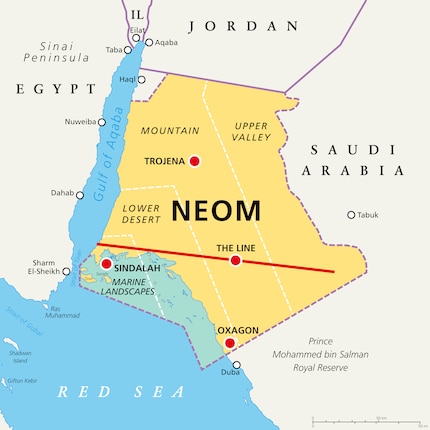
"The Line: Why Saudi Arabia's ambitious city of the future isn't ideal
Saudi Arabia wants to build a 170-kilometre-long city in the desert with the sensational large-scale project "The Line". From a mathematical point of view, "The Circle" would be more efficient.
In October 2022, construction work began on the megaproject "The Line", a 170-kilometre-long planned city in the Saudi Arabian desert. Nine million people are to be accommodated within just 34 square kilometres - an area comparable to Hockenheim, which only has 21,000 inhabitants. This is to be achieved through unique urban planning: "The Line" is to consist of two long rows of 500 metre high skyscrapers facing each other at a distance of 200 metres, enclosing the desert city like a wall. Urban life there is also intended to be as sustainable as possible: Cars have no place in the futuristic city and the entire energy supply is to be emission-free.
In a paper published in "Nature Partner Journal Urban Sustainability" in June 2023, mathematician Rafael Prieto-Curiel and physicist Dániel Kondor from the Complexity Science Hub Vienna argue that "The Line" is not particularly sustainable from a mathematical point of view. "A line is the least efficient form for a city," says Prieto-Curiel in a press release. "There is a reason why mankind has built 50,000 cities that are all somehow round."
The main problem with the chosen geometric shape is the huge distances involved: If you randomly pick two people out of the planned city, they are on average 57 kilometres apart, as Prieto-Curiel and Kondor calculate. For comparison: in the South African metropolis of Johannesburg (which has a similar number of inhabitants in the metropolitan region as "The Line" will have in the future, but covers 3357 square kilometres), two people are on average just 33 kilometres apart.

Source: Shutterstock / Peter Hermes Furian
The mobility problem in "The Line" is to be solved by a high-speed train. However, this would need around 86 stations so that everyone has a stop within walking distance. The many stops extend the journey time - in addition, a train cannot reach the desired high speeds in this way. Prieto-Curiel and Kondor calculate that the many stops would mean a person would spend an average of more than 60 minutes travelling to their destination.
The advantage of two-dimensional cities
A much more efficient solution is obvious, according to the two researchers: "The Circle". If the high-rise buildings planned in "The Line" were to be arranged within a circular area, the problems with the long distances would be solved. A circle with the same area as "The Line" (34 square kilometres) has a diameter of just 6.6 kilometres. Two people picked at random would then have an average distance of 2.9 kilometres between them. A high-speed train would not be necessary at all, as everything is theoretically within walking distance. A few additional bus lines and bicycles would suffice. The circular city form would be less eye-catching, but still "most desirable, as it reduces commuting distances and the energy required for transport", write Prieto-Curiel and Kondor.
The main reason for the advantage is that a circular area is two-dimensional from a mathematical point of view, while a line is one-dimensional. In one dimension, the number of reachable places scales linearly with the distance you are willing to walk - whereas in two dimensions, the number increases with the square of the distance. In addition, one-dimensional structures are much more vulnerable than those in higher dimensions. If, for example, a fire breaks out somewhere within "The Line", thousands of people are immediately cut off from a large part of the city. At least the project is getting people to discuss urban forms, says Prieto-Curiel, "and that is immensely important, because cities are growing, especially in Africa".
Spectrum of Science
We are partners of Spektrum der Wissenschaft and want to make well-founded information more accessible to you. Follow Spektrum der Wissenschaft if you like the articles.
[[small:]]
Cover image: Shutterstock / Corona Borealis Studio
Experts from science and research report on the latest findings in their fields – competent, authentic and comprehensible.
From the latest iPhone to the return of 80s fashion. The editorial team will help you make sense of it all.
Show all